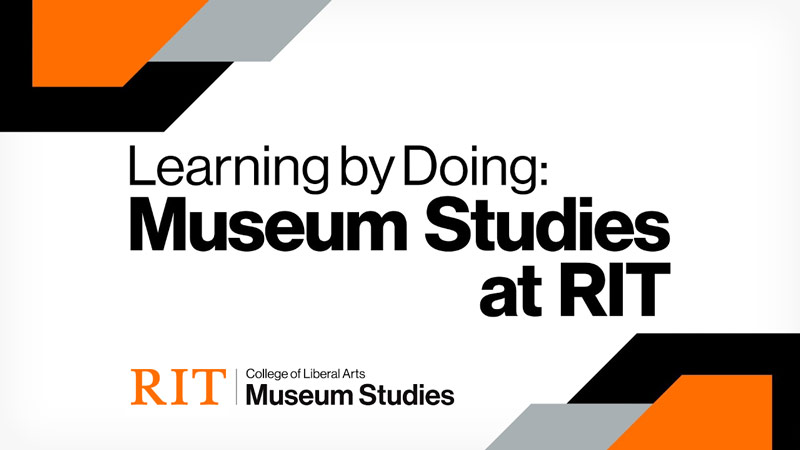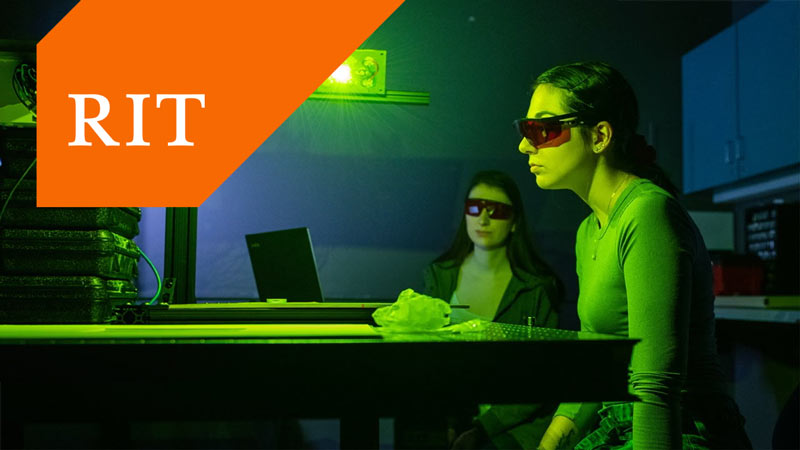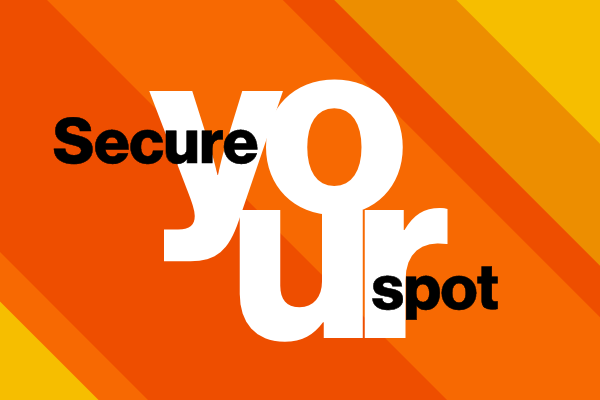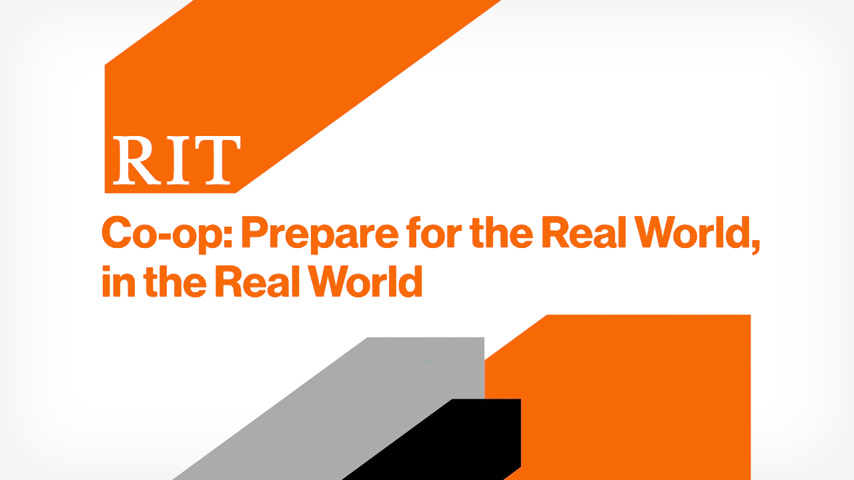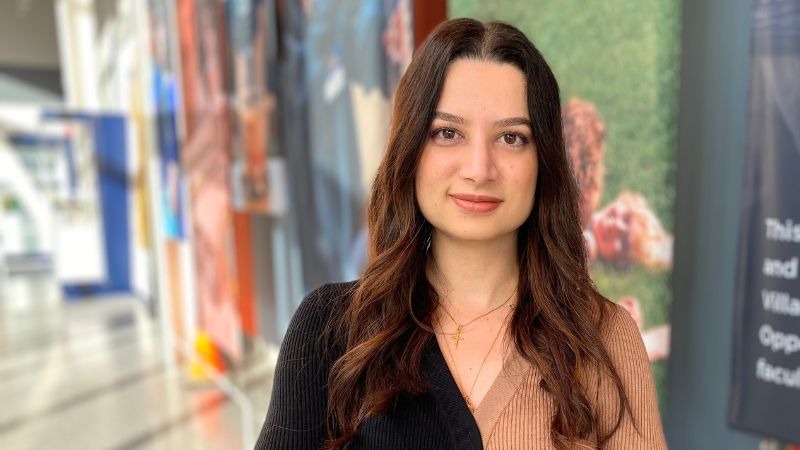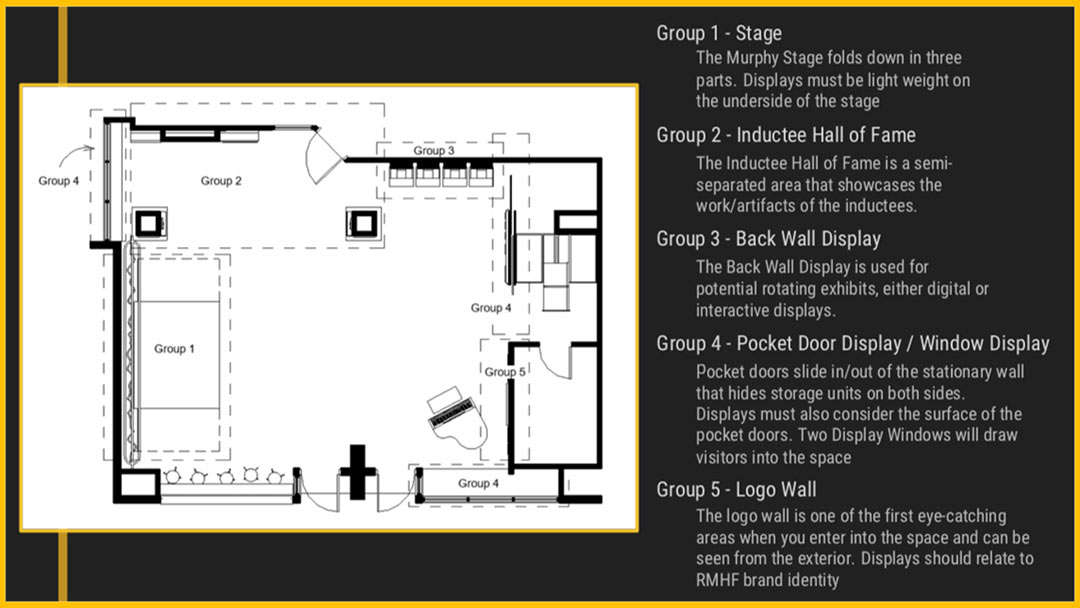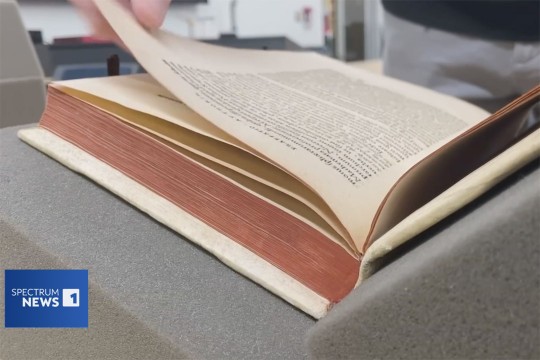Museum Studies Bachelor of Science Degree
- RIT /
- Rochester Institute of Technology /
- Academics /
- Museum Studies BS
Request Info about undergraduate study
Visit
Apply
Department of History
In museum studies, you’ll learn how collections are built, curated, and interpreted and you will apply methods of exhibition and interpretation used in museums, archives, galleries, libraries, and public spaces including national parks.
1st
And only Bachelor of Science in Museum Studies in the U.S.
100%
of grads are either employed, in grad school, or pursuing volunteer or service work.
$400K
Grant-sponsored research funds secured by Museum Studies faculty in the last three years.
+12%
Employment growth predicted in museums and archives.
+6%
Employment growth predicted in libraries.
25,000
Student internship hours at cultural heritage institutions such as museums, archives, and libraries.
$1.3M
Gift that supports the university-museum partnership.
Overview for Museum Studies BS
Why Pursue a Museum Studies Degree at RIT?
- World-class Resources: RIT Collections on campus include RIT Archives, The Cary Graphic Arts Collection, The Dyer Art Center at NTID, and The Vignelli Center for Design Studies.
- Hands-On Experience: Gain real-world career experience in criminal justice that sets you apart from the competition by participating in an optional co-op.
- Top Employers: Recent graduates are employed by Genesee Country Village & Museum; George Eastman Museum; New York Public Library; Smithsonian Institution; The Strong; and Susan B. Anthony Birthplace Museum
- Teaching Partnership Program Available: 4+1 or 3+2 programs enable you to earn your bachelor’s degree at RIT and a master’s degree in education at one of our partner universities.
What is Museum Studies?
Museums, archives, libraries, and other cultural institutions seek emerging professionals who can help develop and implement strategies to digitize, exhibit, manage, curate, and interpret their artistic, cultural, historical, and scientific collections and make them available to the public in interactive and engaging ways. Museum studies provide a thorough grounding in the history, theory, and practice of institutional collecting, exhibition development and design, multi-platform technologies, collection management, fundraising, and grant writing. You’ll be prepared to help institutions share their collections, engage with their communities, and enhance, assess, and improve the visitor experience.
RIT’s Degree in Museum Studies
At RIT, museum studies is an interdisciplinary, technology-infused major that prepares you for careers in museums, archives, libraries, galleries, historical societies, and other cultural organizations.
Three principles guide our program and your academic experience:
- Tech-infused and collections-based curriculum, projects, and initiatives, making use of RIT’s resources from across campus, including the new makerspace in the SHED
- Collaboration across campus and in the community to highlight the interdisciplinary nature of museum work
- Equity-focused work that can take many forms, including foregrounding under-studied narratives from Rochester’s history and democratizing access to technology.
RIT's Museum Studies Courses
The museum studies major at RIT includes a set of introductory core courses to familiarize you with the history, theory, and practice of institutional collecting. These courses are bolstered by classes in exhibition development, education and interpretation, and multi-platform interpretation and design. To broaden and deepen your knowledge, you will choose from a selection of electives that cover a range of topics and areas of studies that can speak to your interests and passions.
You will also complete at least one co-op or internship experience in a cultural institution or similar entity.
Overall, the museum studies curriculum is anchored around museum studies courses that reflect current opinions about necessary skill sets, competencies, and subject areas identified by the Museum Studies Network (MSN) of the American Alliance of Museums (AAM), International Council of Museums (ICOM), and the National Council on Public History (NCPH). You will also acquire skills of critical reflection, sound argumentation, and presentation of information to public audiences in a variety of formats.
Collections, Exhibit Spaces, and Labs
RIT has long been a hub of creativity. See and experience it for yourself, tap into generations of inspiration, and use it as a springboard for your own.
RIT Collections:
- RIT Archives collects and makes accessible physical and digital materials relating to the rich history of RIT, Deaf culture and history, artwork by RIT alumni, faculty, and students, and other special collections.
- The Cary Graphic Arts Collection is one of the world’s premier libraries on graphic communication history and practices, holding 45,000+ volumes and more than 130 archival collections.
- The Dyer Art Center at NTID houses several state-of-the-art galleries that showcase artworks created by current students, alumni, and artists who are nationally and internationally renowned. All of these artists are deaf, hard of hearing, and/or allies of the Deaf community.
- The Vignelli Center for Design Studies is a hub of research, education, and creative inspiration that houses more than 750,000 artifacts across all fields of design.
Exhibit Spaces:
Student-led and faculty-led displays and exhibitions at RIT’s exhibit spaces are the result of collaboration with professionals and artists locally, regionally, and worldwide — exposing you to the latest techniques and trend makers in the industry:
- University Gallery, in Booth Hall
- Wehrheim Gallery in the SHED
Jobs in Museums Studies
A career in museums, archives, libraries, other cultural institutions, or cognate fields awaits you! The good news is that the occupational outlook for archives and museums is very good, with a 12% growth predicted in the next decade, and the outlook for libraries is good, with a 6% growth for library media specialists predicted by the Bureau of Labor Statistics in the next decade.
Upon graduation, you will be prepared for a variety of positions in museums, historical sites, historical societies, libraries, archives, and corporations or other organizations with cultural repositories that develop and implement strategies to digitize, exhibit, manage, curate, and interpret their artistic, cultural, historical, and scientific collections, and to make them available to the public in interactive and engaging ways.
You may also wish to further your education in graduate programs in library and information science, archival studies, informatics, or a number of disciplines including art history and related humanities fields, business, color science, imaging science, and other disciplines that can build upon the firm foundation of liberal arts and tech-infused courses and projects that are cornerstones of the museum studies degree program.
Further Your Education in Museum Studies
Combined Accelerated Bachelor's/Master's Degrees: Today’s careers require advanced degrees grounded in real-world experience. RIT’s Combined Accelerated Bachelor’s/Master’s Degrees enable you to earn both a bachelor’s and a master’s degree in as little as five years of study, all while gaining the valuable hands-on experience that comes from co-ops, internships, research, study abroad, and more.
- +1 MBA: Students who enroll in a qualifying undergraduate degree have the opportunity to add an MBA to their bachelor’s degree after their first year of study, depending on their program. Learn how the +1 MBA can accelerate your learning and position you for success.
3+3 Accelerated BS/JD Programs
RIT has partnered with Syracuse University’s College of Law and University at Buffalo School of Law to offer accelerated 3+3 BS/JD options for highly capable students. These programs provide a fast track to law school where you can earn a bachelor’s degree at RIT and a Juris Doctorate degree at Syracuse University or University at Buffalo in six years. Interested students may apply to the option directly, with successful applicants offered admission to RIT and conditional acceptance into either Syracuse University’s College of Law or University at Buffalo School of Law.
RIT’s museum studies degree is one of the approved majors for the 3+3 option.
Learn more about the RIT/Syracuse University College of Law 3+3 Option, including admission requirements and frequently asked questions.
RIT’s Teaching Partnership Programs
Whether your goal is to go into early childhood or elementary education, become a secondary education teacher with a content area specialty at the middle or high school level, or work in the higher education or counseling fields, RIT’s partnership programs with local universities provide a guided pathway to a career in teaching.
These 4+1 or 3+2 programs enable you to earn your bachelor’s degree at RIT and a master’s degree in education at one of our partner universities. As you progress, you’ll benefit from focused academic advising, career exploration opportunities, and resources for research, learning, and skill development.
RIT's museum studies degree is eligible for RIT’s Teaching Partnership Program.
Learn more about RIT’s Teaching Partnership Programs.
Next Steps to Enroll
From deposit to housing, view the first five steps for accepted first-year students.
Careers and Cooperative Education
Typical Job Titles
| Assistant Curator | Collections Associate |
| Document Processor | Gallery Manager |
| Exhibit Project Manager | Archivist |
Industries
-
Museum
-
Research
-
Higher Education
-
Non-Profit
-
K-12 Education
Cooperative Education
What’s different about an RIT education? It’s the career experience you gain by completing cooperative education and internships with top companies in every single industry. You’ll earn more than a degree. You’ll gain real-world career experience that sets you apart. It’s exposure–early and often–to a variety of professional work environments, career paths, and industries.
Co-ops and internships take your knowledge and turn it into know-how. A liberal arts co-op provides hands-on experience that enables you to apply your knowledge in professional settings while you make valuable connections between course work and real-world applications.
Students in museum studies are required to complete one co-op or internship experience in a cultural institution. Co-ops are usually a summer or semester in duration. Internships may be full- or part-time and are often completed during the semester. They vary in duration depending on the organization. Co-ops and internships may be completed locally, nationally, or internationally.
Students have recently been placed as interns locally, nationally, and internationally.
Recent local placements include: Genesee Country Village & Museum; George Eastman Museum; Memorial Art Gallery; Strong, National Museum of Play; Out Alliance; India Community Center; and the Rochester Public Library. Beyond Rochester, students have served as interns at the Penn Museum; Baseball Hall of Fame; Smithsonian Institution; National Park Service; and National Geographic.
Featured Work
Traveling Exhibition Makes a Powerful Social Impact
Samaya Nasr
Featuring work by Samaya Nasr, Lecturer, RIT Department of History
Providing Discoverability and Accessibility of Historical Documents to Museums and Libraries
Juilee Decker, David Messinger, Steven Galbraith
Students in the Museum Studies degree program are working alongside research scientists from the College of Science Chester F. Carlson Center for Imaging Science to create, test, and iterate a low...
Rochester Music Hall of Fame: Stage and Exhibit Spaces
Students in the Spring 2019 Visitor Engagement and Museum Technologies course worked with teams from RIT’s Interior Architecture Program and the Kate Gleason College of Engineering in developing a new...
Featured Profiles
Melissa Sagen
’15
“My professors each encouraged my passion for film preservation in their own unique ways. It was meaningful to have that type of positivity and reassurance while I was discovering how I fit in and...
Preserving Lost History
As an archivist, Kayla Jackson '18 is effectively restoring the lost history of the Black community in St. Paul, Minnesota by preserving and digitizing historical documents.
Curriculum for 2023-2024 for Museum Studies BS
Current Students: See Curriculum Requirements
Museum Studies, BS degree, typical course sequence
| Course | Sem. Cr. Hrs. | |
|---|---|---|
| First Year | ||
| MUSE-220 | Introduction to Museums & Collecting (General Education - Social Perspective) This course examines the history, theory, and practice of museums by situating them as social institutions emerging within their broader historical and cultural contexts, from their origins in the mouseion of the classical era and Renaissance cabinets of curiosities to the modern era’s World’s Fairs and museums of today. The evolution and range of museum functions are addressed. Building on these foundations, the following types of museums and institutions are explored: art and design, natural history, anthropology, science, and history museums, as well as historic houses and sites, botanical gardens, and zoos. In studying the histories and functions of museums through the lenses of social institutions, the course highlights the evolution of museums institutionally, ideologically, and experientially. The course considers the operations of museums, governance, and the professional ethics and legal constraints that affect museum professionals; examines museums and their practices through the perspectives of colonialism and de-colonialization, nationalism, class, gender, ethnicity, anti-racism, and community; and includes field trips to local institutions and on-campus site visits throughout the semester. Lecture 3 (Fall). |
3 |
| MUSE-221 | Introduction to Public History (General Education - Elective) Public history is using the research-based methods and techniques of historians to conduct historical work in the public sphere. If you've gone to a museum, conducted an oral history, researched your old house, or learned from an interpreter at a park or historic site, you've seen public history in action. This course will introduce students to the wide variety of careers in public history, and will examine the challenges and opportunities that come with doing history in, with, and for the public. Lecture 3 (Spring). |
3 |
| YOPS-10 | RIT 365: RIT Connections RIT 365 students participate in experiential learning opportunities designed to launch them into their career at RIT, support them in making multiple and varied connections across the university, and immerse them in processes of competency development. Students will plan for and reflect on their first-year experiences, receive feedback, and develop a personal plan for future action in order to develop foundational self-awareness and recognize broad-based professional competencies. (This class is restricted to incoming 1st year or global campus students.) Lecture 1 (Fall, Spring). |
0 |
General Education – Ethical Perspective |
3 | |
General Education – First-Year Writing (WI) |
3 | |
General Education – Global Perspective |
3 | |
General Education – Mathematical Perspective A |
3 | |
Specialized Electives I |
3 | |
Museum Studies Electives I,II |
6 | |
General Education - Elective |
3 | |
| Second Year | ||
| MUSE-224 | History & Theory of Exhibitions (General Education - Artistic Perspective) Exhibitions are organized around a creative curatorial premise, a statement that articulates an idea allowing for the selection of work included in an exhibition. This course begins with an overview of exhibition history, starting with the transformation of the Louvre into the first public art museum following the French Revolution, where art history, a discipline developed in the 19th century, was enlisted to organize exhibitions. The class analyzes how art and exhibitions represent the cultural contexts in which they are created. The course examines the proliferation of types of exhibitions that accompanies modernism, up to the present, paying close attention to the curatorial premise animating the exhibitions. Lecture 3 (Spring). |
3 |
| MUSE-340 | Introduction to Archival Studies This course introduces students to the role of archives in the construction of a society’s cultural heritage and historical identity. Archives are repositories of a culture’s original documents, both paper and electronic, and they function as a site for the construction, preservation, and dissemination of historical memory, as a source for social responsibility, and as a tool for the understanding of the cultural, social, and political forces that influence events. The course will examine the history of archives, the theory and practice that guide the work of archivists, and examine the basic components of an archival program: including acquisition and appraisal, arrangement and description, preservation and legal and ethical issues related to access to archival records. The class will also cover the transformation of the profession in the digital age, including digital preservation, the work of archival appraisal and collection building in an age of digital proliferation, and archival collection management systems. Lecture 3 (Fall). |
3 |
| MUSE-341 | Museum Education & Interpretation This course introduces students to the educational mission of the museum and to the museum’s role in educating citizens for participation in a democratic, pluralistic society. As sites of informal learning, museums have an educational impact on our lives beyond our formal schooling. The course focuses on a wide range of educational activities within museums that address visitors of all ages as individuals and as members of a democratic society, and helps to foster in them a sense of community, civic responsibility, tolerance for multiple viewpoints, and lifelong love of learning. The course examines the institutional shift from a fixed, scholarly approach to exhibiting collections to one that embraces the concept of interpretation, where visitors are encouraged to engage in a variety of experiences, make their own connections with objects and other visitors, and ultimately construct their own meanings. Lecture 3 (Fall). |
3 |
General Education – Immersion |
3 | |
General Education – Natural Science Inquiry Perspective ‡ |
3 | |
General Education – Scientific Principles Perspective |
3 | |
General Education – Mathematical Perspective B |
3 | |
General Education - Elective |
3 | |
Museum Studies Elective III |
3 | |
Open Electives |
3 | |
| Third Year | ||
| MUSE-354 | Exhibition Design This course examines the history and practice of exhibition design. It reviews the history of exhibitions within the development of museum-like institutions. In this course the following aspects of exhibition design are considered: curatorial premise or theme, exhibition development timeline, exhibition site, contracts and contractual obligations, budgets and fundraising, publicity material, didactic material, and exhibition design. The course includes field trips to local institutions and collections throughout the term. Lecture 3 (Fall). |
3 |
| MUSE-357 | Collections Management & Museum Administration This course presents an overview of the administration and management of museums and their collections. The course examines the governance structure of museums, focusing on personnel responsible for their administration, curation and education, and operations, as well as on the mission statement and policies they determine. The course also details the management of collections, including the development of a collections policy, management of that policy, documentation and record keeping, acquisitions, and the creation/management of exhibitions. Finally, the course considers collections care or preventive conservation, looking at both the facility and collections. Throughout the term, legal and ethical issues pertaining to museums and their collections will be emphasized. (Prerequisites: MUSE-220 or 0533-421 or equivalent course.) Lecture 3 (Spring). |
3 |
General Education – Immersion 2 |
3 | |
General Education – Elective |
6 | |
Museum Studies Electives IV |
3 | |
Open Elective |
6 | |
Specialized Electives II, III |
6 | |
| Choose one of the following: | 0 |
|
| MUSE-497 | Museum Studies Internship (summer) Internship in a field related to Museum Studies (at least 50 hours). Students will apply the accumulated knowledge, theory, and methods of the discipline to problem solving outside of the classroom. (MUSEUM-BS) Internship (Fall, Spring, Summer). |
|
| MUSE-498 | Museum Studies Co-Op Part Time (summer) Co-op in a field related to museum studies (at least 80 hours). Students will apply the accumulated knowledge, theory, and methods of the discipline to problem solving outside of the classroom. (MUSEUM-BS) CO OP (Fa/sp/su). |
|
| MUSE-499 | Museum Studies Co-op (summer) Co-op in a field related to museum studies (at least 200 hours). Students will apply the accumulated knowledge, theory, and methods of the discipline to problem solving outside of the classroom. CO OP (Fall, Spring, Summer). |
|
| Fourth Year | ||
| MUSE-489 | Research Methods (WI-PR) This class introduces students to the methods of research appropriate for scholarship in the field of Museum Studies. Students will learn how to locate, analyze, assess, critique and conduct research in the field. They will choose the topic of their senior thesis project, develop a clear statement of how that topic will be explored, and construct an annotated bibliography relevant to that topic. This course leads to the development of a proposal for a senior thesis project that is suitable for full implementation in Senior Thesis for museum studies. (This class is restricted to students with at least 3rd year standing in MUSEUM-BS.) Research 3 (Fall, Spring). |
3 |
| MUSE-490 | Senior Thesis in Museum Studies (WI-PR) The Senior Thesis in Museum Studies is the final requirement in the degree program. Students will conduct the appropriate research to address the topic they had proposed in Research Methods. They will present their results as a formal written thesis and in an appropriate public forum. The course provides students the opportunity to develop their research and practical skills and to share the results with the department and the college. (Prerequisites: MUSE-489 or equivalent course.) Research 3 (Fall, Spring). |
3 |
General Education – Electives |
9 | |
General Education - Immersion 3 |
3 | |
Museum Studies Electives V, VI |
6 | |
Open Electives |
6 | |
| Total Semester Credit Hours | 120 |
|
Please see General Education Curriculum (GE) for more information.
(WI-PR) Refers to a writing intensive course within the major.
* Please see Wellness Education Requirement for more information. Students completing bachelor's degrees are required to complete two different Wellness courses.
‡ Students will satisfy this requirement by taking either a 3- or 4-credit hour lab science course. If a science course consists of separate lecture and laboratory sections, the student must take both the lecture and lab portions to satisfy the requirement.
Specialized Electives
| Course | |
|---|---|
| MUSE-225 | Museums & the Digital Age The digital revolution has profoundly influenced how we think about the world around us. Information once available only to experts is now accessible digitally to a much broader audience. Museums, archives, and libraries have adapted to this democratization of knowledge and decentralization of access in myriad ways. As visitors to museums—whether online or onsite—each of us is part of the creation, consumption, and reception of digital information. What does this mean for museums and for us as audiences and consumers of such information? How has the combination of digital technology and social media increased visitors’ abilities for interaction with cultural institutions, their collections, and other visitors? This course will examine the history and evolution of museum practices as they adapt to new technologies and rethink traditional museum practices. The course has no pre-requisite and is open to students of all majors. Lecture 3 (Fall). |
| MUSE-226 | Introduction to Digital Cultural Heritage Cultural heritage is a fluid term that applies broadly to the creation, protection, and preservation of material objects and intangible practices for future generations. This course examines the concepts associated with tangible, intangible, and natural cultural heritage with a global outlook. Through readings, discussion, and projects, the course explores the various forms that cultural heritage takes and frames them in terms of digital creation, consumption, and preservation. Course content may be site-specific. Lecture 3 (Spring). |
| MUSE-359 | Digital and Critical Curation This course introduces students to Cultural Informatics, the interdisciplinary field that examines the intersections of information technologies, information science, and cultural information centered in museums, libraries, and archives. Among the topics to be examined are: how information technologies are used in museums, libraries, and archives; how modern information systems have shaped the museum environment; the nature of convergence; the development of digital collections, digital curation, and online exhibitions; and the role and status of the information professional in the museum and cultural organizations. The course is designed around projects, case studies, and readings so that students gain hands-on experience working with information. The course has no prerequisite and is open to students of all majors. Lecture 3 (Fall). |
| MUSE-360 | Visitor Engagement & Museum Technologies All of us, as museum visitors, have the capacity to engage with collections and to create meanings as a result of such interaction. This course considers the history and theory of visitor engagement at museums, galleries, and sites of cultural heritage tourism; examines the import of technology into this history; and articulates the role of visitors as participants who curate their own experiences. Two key questions will be addressed in this course: 1) How does technology provide a platform for contribution, collaboration, co-creation, and co-opting of experiences among all visitors? and 2) Can technology mediate the best possible experience for visitors? The course has no prerequisite and is open to students of all majors. Lecture 3 (Spring). |
Museum Studies Electives
| Course | |
|---|---|
| ANTH-328 | Heritage and Tourism Tourism is a global industry and an important part of the human experience. There are many forces within tourism that act upon people’s lives, and in particular their environments, economies, cultural heritage, and identity. This course will explore tourism and its many dimensions. Beginning with an examination of kinds of tourism, this course unpacks tourism’s ancient trade and pilgrimage roots as well as its class dynamics of post-industrialization. Other aspects of tourism to be explored include strategies and effects of tourism development and production, nationalism and cultural identity, commoditization and marketing of culture and the ethics of development, labor and infrastructural changes, social inequalities, ecological impact, sustainable tourism, the experience of tourists, ritual and authenticity, and the relationship between tourists and tourism workers. This course provides opportunities for cross-cultural analysis of tourism sites, for participant-observation of the tourist experience, and for evaluation and recommendation of tourism site development in and around Rochester. Lecture 3 (Fall, Spring). |
| ANTH-415 | Archaeological Science Archaeology is one of the few social sciences that lends itself well to the application of analytical techniques from the physical sciences. This is due to the fact that archaeology relies primarily on physical evidence, artifacts and features, whose origin, composition, age, and manner of production can be elucidated through application of the physical sciences. This course examines the application of physical science techniques to archaeological questions, including the age and origin of materials, how things are made, what people ate, their daily activities, and their state of health throughout their life. The course will include in-class labs in which students have the opportunity to apply some of these techniques and a final research project in which the student picks their own archaeological question to answer. Lab 2, Lecture 2 (Fall or Spring). |
| ARTH-135 | Survey: Ancient to Medieval Art In this course students will examine the forms, styles, functions, and meanings of important objects and monuments dating from prehistory through the Middle Ages, and consider these works of art in their social, historical and cultural contexts. The primary goals of this course are to learn how to look, how to describe and analyze what we see, and how to use these skills to understand and explain how art visually expresses meaning. At the end of the term, students will have gained a foundational knowledge of the object, scope and methods of the discipline of art history. The knowledge obtained in this introductory course will also guide students in their own creative endeavors. Lecture 3 (Fa/sp/su). |
| ARTH-136 | Survey: Renaissance to Modern Art In this course students will examine the forms, styles, functions, and meanings of important objects and monuments dating from the Renaissance through the beginning of the twentieth century, and consider these works of art in their social, historical and cultural contexts. The primary goals of this course are to learn how to look and how to describe and analyze what we see, and to use these skills to understand and explain how art visually expresses meaning. At the end of the term, students will have gained a foundational knowledge of the object, scope and methods of the discipline of art history. The knowledge obtained in this introductory course will also guide students in their own creative endeavors. Lecture 3 (Fa/sp/su). |
| CLRS-201 | Color Science for the Visual Arts Color has been a topic of intense interest and inquiry for thousands of years. Knowledge of color science can be an aid to visual artists and those who study the visual arts such as art historians and conservators. Topics include the building blocks of color, seeing color, producing color, displaying color, reproducing color, and conserving color. Lecture 3 (Spring). |
| DHSS-103 | Ethics in the Digital Era The course will examine various contemporary and global issues of digital citizenship and new ethical challenges raised by digital technology. The course will raise questions regarding how digital technology has changed citizenship practices: Who has access to full citizenship, and why? What responsibilities are entailed in digital citizenship? Themes may include the nature and value of digital technology; the relations between digital technologies and knowledge-making/meaning-making; the value of information privacy; the role of digital media in society and human interactions; issues arising from the life-cycle of new digital tools and data repositories; and questions broadly related to questions of accessibility, representation, and sustainability as applied to digital technologies. Topics may also include research ethics, piracy and file sharing, hacktivism, copyright and fair use, end-user license agreements, alternative news media, and participatory culture. Students will take up both broad ethical issues and specific professional codes and policy in diverse domains. Lecture 3 (Spring). |
| HIST-101 | Making History How do historians understand and interpret the past? What tools do historians use to uncover the past? What does it mean to think historically? History is both an art and a science, and in this course, we will learn the methods, practices, and tools used to create historical knowledge. You will learn how to read texts with an eye toward their argument, how to ask historical questions, how to conduct historical research, and how to write a historical narrative. At the discretion of the instructor, the class may use examples from a particular historical era to ground course concepts in a specific historical tradition. Lecture 3 (Fall). |
| HIST-125 | Public History and Public Debate In late 1994, the B-29 Superfortress Enola Gay, the airplane that dropped the first atomic bomb detonated in combat on Hiroshima, Japan, arrived at the Smithsonian National Air and Space Museum in Washington, DC. The museum’s staff faced important questions: Would they celebrate the Enola Gay as the weapon that ended the Pacific War? Would they exhibit it as a technological artifact that marked the dawn of nuclear warfare? Would they remind museum visitors that its potent cargo ended the lives of tens of thousands of people? These were difficult professional questions for public historians; they were deeply ethical questions too.
Much of the past that public historians interpret is the source of great debate in the present. Since the way history is remembered shapes public policy, community identity, and collective understanding, the ethical stakes for public history are high. This course will examine notable controversies in American public history and develop students’ critical perspectives on them. Students will generate answers to the questions: What are the ethics of doing public history? What happens when public historians remember, but the community wants to forget? When stakeholders (e.g., historic site, community, historians, sponsors) collide, whose stories and whose interests prevail? Who decides? How are those decisions made? Who is allowed to tell history? To whom or to what are public historians responsible? Lecture 3 (Fall, Spring). |
| HIST-322 | Monuments and Memory Monuments are physical objects that were constructed to help us remember the past, but a deeper analysis reveals that the relationship between monuments and the memories they embody is complex and changes over time. We will tackle the process of memorializing, the monuments that result, and seek greater insight into the arguments these artifacts make about the past, the present, and our place in the world. Lecture 3 (Fall). |
| HIST-323 | America's National Parks The National Parks are some of America's most treasured and spectacular landscapes, but even these wild places are the product of historical forces. In this class, we will explore the history of America's National Parks, and use these spaces to unpack the relationship between Americans, their land, and their history. Lecture 3 (Spring). |
| HIST-324 | Oral History Oral history collects memories and personal commentaries of historical significance through recorded interviews. There are few opportunities for historical research that are more satisfying or more challenging than oral history. In this class, we will learn about oral history methods, techniques, and ethics. We will read, listen to, and watch some of the finest examples of the genre. Then we will go out and add to the world's understanding of its past by conducting oral histories of our own. For their final project in this course, students will work in teams to produce a podcast based on their own interview(s). Lecture 3 (Fall). |
| HIST-325 | Museums and History Many more people learn history from museums than from textbooks. What is it that is so special about encountering the real thing in a museum? Why are Dorothy's Ruby Slippers the most visited artifact in the National Museum of American History? Do history museums themselves have an important history? Join us as we investigate the connections between our history, our museums, and the material artifacts that tell historical stories. Lecture 3 (Spring). |
| IMGS-115 | Cultural Heritage Imaging This course introduces non-science majors to the primary imaging technologies currently used in the field of cultural heritage, in support of the preservation and conservation of artifacts in museums, archives, libraries, and other institutions. Understanding historical manuscripts and artifacts of historical and cultural heritage significance is an important part of studying both past and present cultures. The use of modern imaging technologies to discover, understand, and preserve these artifacts is becoming an important and rapidly growing field of exploration, and combines aspects of history, languages, material science, and specialty imaging. This course will introduce students to the basic concepts behind the primary imaging technologies used in the field of cultural heritage research, with a focus on passive spectral imaging. The course also provides a more detailed description of various imaging modalities, e.g., spectral, x-ray, 3D, etc., and basic image processing concepts used to extract information from spectral imagery. Real data from cultural heritage image collections will be used as examples for in-class demonstrations, whenever possible. Students also will work on projects related to image collection and processing, as applied to data from works of cultural value. Lecture 3 (Fall, Spring). |
| MUSE-241 | Topics in Museum Studies: Art, Design, & Exhibition Projects This variable topic course examines one or more methods, concepts, or theories of museum studies and its intersection with art, craft, and design. Whether focusing on the content of collections (i.e., fine art, craft, design, or other disciplines) or the conceptual development of displays informed by a curatorial premise informed by methods, concepts, and theories of museum studies, the course frames art and design collections in relation to exhibition projects. The course centers themes, figures, movements, or issues associated with artistic practice, and/or the historical, cultural, and theoretical questions of exhibitions and display. The topic for the course is chosen by the instructor, announced in the course subtitle, and developed in the syllabus, particularly through the readings and deliverables. The course can be taken multiple times provided that the topic is different. The artistic framing for these topics may center one or both of the following areas of inquiry: art, craft, and design as the subject of the course (i.e., focusing on the collections held by RIT at the Dyer Arts Center, Cary Graphic Art Collection, and Vignelli Center for Design Studies) and/or creative approaches to deliverables, from ideation to presentation in one of the gallery spaces at RIT, or in another exhibition space (including online). Lecture 3 (Fall, Spring). |
| MUSE-244 | Topics in Museum Studies: Museums and Society This variable topic course examines one or more methods, concepts, or theories of museum studies as a framing for understanding of the diversity of human cultures today and over time. Whether focusing on the content of collections (i.e., cultural heritage, undocumented migration, wrongful imprisonment, de-colonization) or the conceptual development of displays informed by a curatorial premise informed by methods, concepts, and theories of museum studies, the course examines topics of social relevance in relation to exhibition projects. The course centers themes, figures, movements, or issues of contemporary society, and/or the historical, cultural, and theoretical questions of exhibitions and display. The topic for the course is chosen by the instructor, announced in the course subtitle, and developed in the syllabus, particularly through the readings and deliverables. The course can be taken multiple times provided that the topic is different. Lecture 3 (Spring). |
| MUSE-249 | Topics in Archives, Museums, and Community Collections Topics courses offer the opportunity to build knowledge specific to events, issues, and opportunities unique to archives, museums, and collecting institutions. Topics and methods vary from term to term, though each offering features an introduction to a concept, methodology, institution, or other subfield of study within museum studies or public history. Students develop theoretical and experiential knowledge of the topic under investigation while fostering opportunities to respond to recent events or to partner with local organizations and institutions. Students also create deliverables appropriate to the experience. The topic will be announced prior to the course offering. The course may be repeated for credit since topics will normally vary from semester to semester. Lecture (Fall or Spring). |
| MUSE-361 | Tablet to Tablet: A History of Books From ancient clay and wax tablets, to scrolls and medieval manuscripts, to printed books and iPads, this class examines the history of books from 2300 BCE to the present. Students study books not only as vehicles for texts, but also as physical artifacts that carry with them important evidence of the cultures that produced and read them. Using the Cary Graphic Arts Collection as their research laboratory, students investigate the evolution of books through hands-on interaction with artifacts both ancient and modern, while also pondering what forms future books might take. Lecture 3 (Spring). |
| MUSE-388 | Gender and Contemporary Art This course traces the historical development of women’s activism in the art world from the 1970s to the present. We will interpret how this art activism, which artists and scholars alike have referred to as the feminist art movement, has examined how gender informs the ways art is made, viewed, conceptualized in history and theory, and exhibited in museums and visual culture, in a range of cultural contexts. We will also analyze how current artists, critics, and curators continue to build on this history, in particular how they use the concept of gender intersectionally to develop a variety of new creative practices, theories, modes of exhibition and social engagement. Lecture 3 (Spring). |
| MUSE-449 | Special Topics Museum Studies A focused, in-depth critical examination and analysis of a selected topic in Museum Studies, varying according to faculty teaching the course. Lecture 3 (Spring). |
| SOIS-128 | Major Issues in Criminal Justice Students will learn about a variety of community-based cultural practices by engaging with international and regional examples of material culture, customs and rituals, and narrative traditions. Applying theoretical perspectives gained through readings and discussion, students will evaluate the way those traditions reflect class, gender, and ethnic identity. Students will also learn basic ethnographic research methods and document traditional cultural practices found in their own communities. Lecture 3 (Spring). |
| STSO-326 | History of Ecology and Environmentalism This course explores the history of ecological science, from the eighteenth century to the present, and it features the political use of ecological ideas in environmental debates, from the 19th century to the present. We investigate how social and political ideas have influenced ecological science, how ecological concepts have influenced Western politics and society, and how different generations of ecological researchers have viewed their role in society. Lecture 3 (Fall). |
| STSO-510 | Interdisciplinary Capstone Seminar This course is an upper-level undergraduate seminar that explores how science, technology, society, environment and policy are understood in contemporary and historical contexts. The course brings together a variety of views and readings to offer an interdisciplinary approach to understanding the complex ways in which citizens make and understand the world. (Enrollment in Department of STS/Public Policy) Lecture 3 (Fall, Spring). |
| STSO-521 | Biodiversity and Society This course explores the problems, issues, and values stemming from the current massive loss of biodiversity. Various justifications for preserving or conserving biodiversity will be examined. Although principals of conservation biology are presented, the social/cultural dimensions of the issue will be emphasized. Lecture 3 (Spring). |
Admissions and Financial Aid
First-Year Admission
A strong performance in a college preparatory program is expected. This includes:
- 4 years of English with a strong performance is expected.
- 3 years of social studies and/or history with a strong performance is expected.
- 3 years of math is required and must include algebra, geometry, and algebra 2/trigonometry.
- 2-3 years of science.
Transfer Admission
Transfer course recommendations without associate degree
Courses in liberal arts, art history, studio arts, photography, business, and chemistry
Appropriate associate degree programs for transfer
Fine arts, Liberal arts, or business/marketing
Financial Aid and Scholarships
100% of all incoming first-year and transfer students receive aid.
RIT’s personalized and comprehensive financial aid program includes scholarships, grants, loans, and campus employment programs. When all these are put to work, your actual cost may be much lower than the published estimated cost of attendance.
Learn more about financial aid and scholarships
Latest News
-
April 11, 2024
![the cover of Rochester history is shown]()
Spring issue of ‘Rochester History Journal’ publishes with new digital format
Published by RIT Press, in partnership with the RIT Department of History and the Central Library of Rochester and Monroe County, Rochester History Vol 81, No. 2 (spring 2024) is a peer-reviewed biannual journal that explores local issues within a national and global context.
-
February 22, 2024
![a centuries old text appears on the screen being handled delicately]()
Rare, centuries-old astronomy texts donated to RIT
Spectrum News talks to Steven Galbraith, curator of the Melbert B. Cary Graphic Arts Collection, about the books.
-
January 24, 2024
![a photo of james in the gallery as he was setting up the exhibit]()
Exploring themes, motivations, and the influencing power of historic military propaganda
A collection of war era ephemera and propaganda art on display now at the University Gallery connects viewers to the experiences and perceptions of the time.













